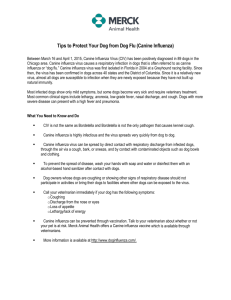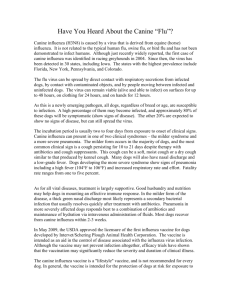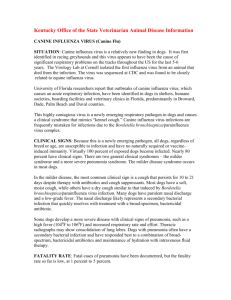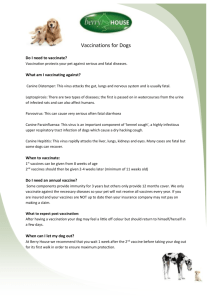Canine Influenza Backgrounder _____________________________________________ (10/24/05)
advertisement
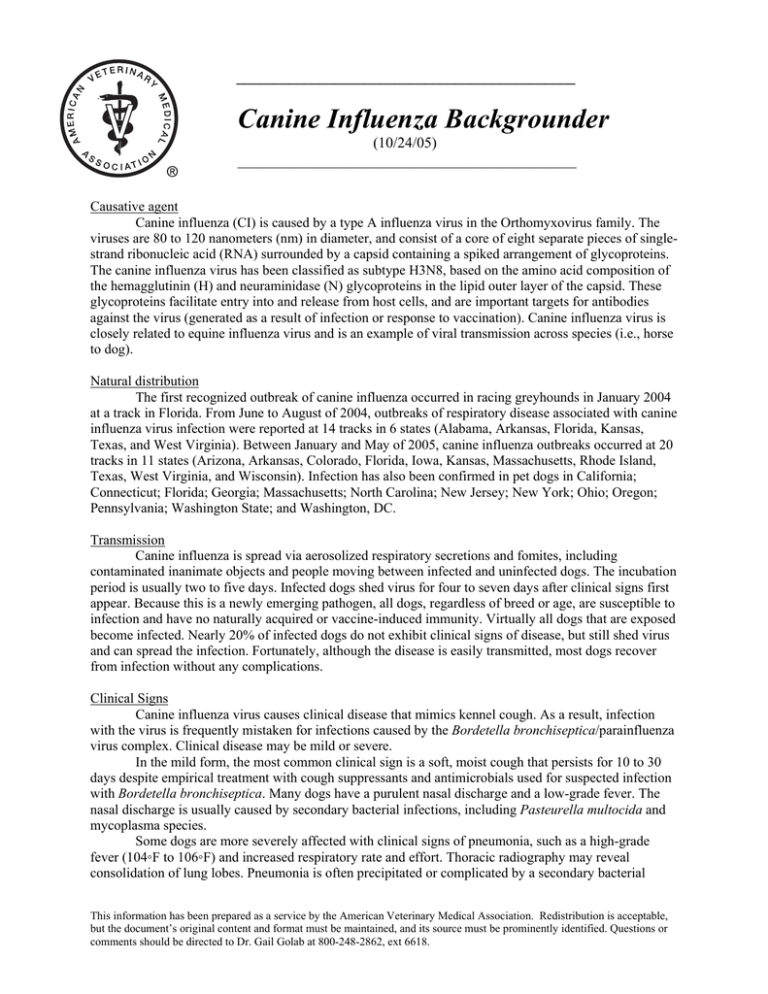
_____________________________________________ Canine Influenza Backgrounder (10/24/05) _____________________________________________ Causative agent Canine influenza (CI) is caused by a type A influenza virus in the Orthomyxovirus family. The viruses are 80 to 120 nanometers (nm) in diameter, and consist of a core of eight separate pieces of singlestrand ribonucleic acid (RNA) surrounded by a capsid containing a spiked arrangement of glycoproteins. The canine influenza virus has been classified as subtype H3N8, based on the amino acid composition of the hemagglutinin (H) and neuraminidase (N) glycoproteins in the lipid outer layer of the capsid. These glycoproteins facilitate entry into and release from host cells, and are important targets for antibodies against the virus (generated as a result of infection or response to vaccination). Canine influenza virus is closely related to equine influenza virus and is an example of viral transmission across species (i.e., horse to dog). Natural distribution The first recognized outbreak of canine influenza occurred in racing greyhounds in January 2004 at a track in Florida. From June to August of 2004, outbreaks of respiratory disease associated with canine influenza virus infection were reported at 14 tracks in 6 states (Alabama, Arkansas, Florida, Kansas, Texas, and West Virginia). Between January and May of 2005, canine influenza outbreaks occurred at 20 tracks in 11 states (Arizona, Arkansas, Colorado, Florida, Iowa, Kansas, Massachusetts, Rhode Island, Texas, West Virginia, and Wisconsin). Infection has also been confirmed in pet dogs in California; Connecticut; Florida; Georgia; Massachusetts; North Carolina; New Jersey; New York; Ohio; Oregon; Pennsylvania; Washington State; and Washington, DC. Transmission Canine influenza is spread via aerosolized respiratory secretions and fomites, including contaminated inanimate objects and people moving between infected and uninfected dogs. The incubation period is usually two to five days. Infected dogs shed virus for four to seven days after clinical signs first appear. Because this is a newly emerging pathogen, all dogs, regardless of breed or age, are susceptible to infection and have no naturally acquired or vaccine-induced immunity. Virtually all dogs that are exposed become infected. Nearly 20% of infected dogs do not exhibit clinical signs of disease, but still shed virus and can spread the infection. Fortunately, although the disease is easily transmitted, most dogs recover from infection without any complications. Clinical Signs Canine influenza virus causes clinical disease that mimics kennel cough. As a result, infection with the virus is frequently mistaken for infections caused by the Bordetella bronchiseptica/parainfluenza virus complex. Clinical disease may be mild or severe. In the mild form, the most common clinical sign is a soft, moist cough that persists for 10 to 30 days despite empirical treatment with cough suppressants and antimicrobials used for suspected infection with Bordetella bronchiseptica. Many dogs have a purulent nasal discharge and a low-grade fever. The nasal discharge is usually caused by secondary bacterial infections, including Pasteurella multocida and mycoplasma species. Some dogs are more severely affected with clinical signs of pneumonia, such as a high-grade fever (104◦F to 106◦F) and increased respiratory rate and effort. Thoracic radiography may reveal consolidation of lung lobes. Pneumonia is often precipitated or complicated by a secondary bacterial This information has been prepared as a service by the American Veterinary Medical Association. Redistribution is acceptable, but the document’s original content and format must be maintained, and its source must be prominently identified. Questions or comments should be directed to Dr. Gail Golab at 800-248-2862, ext 6618. infection. Bacteria recovered from the lungs of some dogs with pneumonia have included Staphylococcus spp, Streptococcus spp, Escherichia coli, Klebsiella, Pasteurella multocida, and mycoplasma spp. Diagnosis There is no reliable rapid test for diagnosis of acute canine influenza virus infection. The most reliable and sensitive method for confirmation of infection is serologic testing. Antibodies to canine influenza virus may be detected as early as seven days after onset of clinical signs and paired acute and convalescent serum samples are necessary for diagnosis of recent infection. Convalescent samples should be collected at least two weeks after collection of the acute sample. If an acute sample is not available, a convalescent sample will indicate whether a dog has been infected at some point in the past. Other diagnostic options applicable to dogs that have died from pneumonia are viral culture and polymerase chain reaction (PCR) analysis, using fresh (not formalin-preserved or frozen) lung and tracheal tissues. Virus detection in respiratory secretion specimens from acutely ill animals by use of viral culture, PCR analysis, or rapid chromatographic immunoassay is possible, but usually unrewarding. The Cornell Animal Health Diagnostic Center is currently accepting samples for analysis. For detailed information on sample submission, visit www.diaglab.vet.cornell.edu/news.asp. Treatment As for all viral disease, treatment is largely supportive. Good husbandry and nutrition may assist dogs in mounting an effective immune response. In the milder form of the disease, a thick green nasal discharge most likely represents a secondary bacterial infection that usually resolves quickly after treatment with a broad-spectrum bactericidal antimicrobial. Pneumonia in more severely affected dogs responds best to a combination of broad-spectrum bactericidal antimicrobials (to combat secondary bacterial infections) and maintenance of hydration via intravenous administration of fluids. Currently available antiviral drugs are approved for use in humans only and little is known about their use in dogs. Veterinarians who use approved drugs in a manner that is not in accord with approved label directions (e.g., use of an antiviral drug only approved for use in humans) must follow the federal extralabel drug use regulations of the Animal Medicinal Drug Use Clarification Act (AMDUCA). Morbidity and Mortality Morbidity associated with canine influenza is estimated at 80%; mortality in confirmed cases to date has ranged from 5 to 8%. Prevention and Control At this time, no vaccine is available to protect against canine influenza. Routine biosecurity precautions are key to preventing spread. The canine influenza virus is an enveloped virus that appears to be easily killed by disinfectants in common use in veterinary, boarding, and shelter facilities, such as quaternary ammonium compounds and bleach solutions. Protocols should be established for thoroughly cleaning and disinfecting cages, bowls, and other surfaces between uses. Employees should wash their hands with soap and water before and after handling each dog; after coming into contact with dogs’ saliva, urine, feces, or blood; after cleaning cages; and upon arriving at and before leaving the facility. Isolation protocols should be rigorously applied for dogs showing signs of respiratory disease. Clothing, equipment, surfaces and hands should be cleaned and disinfected after exposure to dogs showing signs of respiratory disease. Dog owners whose dogs are coughing or exhibiting other signs of respiratory disease should not participate in activities or bring their dogs to facilities where other dogs can be exposed to the virus. . This information has been prepared as a service by the American Veterinary Medical Association. Redistribution is acceptable, but the document’s original content and format must be maintained, and its source must be prominently identified. Questions or comments should be directed to Dr. Gail Golab at 800-248-2862, ext 6618.
